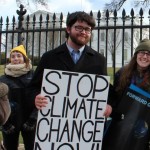By Oliver Peckham
Daniel Lashof, Director of the Climate & Clean Air Program at the National Resources Defense Council (NRDC), spoke at the National Climate Seminar on February 6th.

Mr. Lashof – who has been involved in national climate negotiations since their inception – joined the Seminar to speak about the NRDC’s answer to the question: if the President is serious, what can he actually do about climate change in his second term?
The answer, according to the NRDC? Quite a lot.
Mr. Lashof cited a letter – sent by a coalition of seventy organizations – that laid out three achievable climate change priorities for President Obama:
- Raise your voice. Elevate the issue of climate disruption and climate solutions in the public discourse. …
- Use your executive authority … under existing law to achieve urgently needed reductions in the carbon pollution that is disrupting our climate and damaging our health. …
- Reject dirty fuels. We should not pursue dirty fuels like tar sands[.]
The NRDC’s recent proposal focuses on the second item: the use of existing executive authority to combat climate change. Executive authority is a key area, says Mr. Lashof, because of how difficult it is to see “significant, positive legislation to address climate change” being enacted in the next two years – and how risky it would be to rely on midterm elections changing the current situation.
Executive action on climate change would primarily stem from the Clean Air Act, which has become a “powerful tool” for climate action following the 2007 Supreme Court decision that the EPA has the authority and responsibility to set carbon pollution standards.
While the EPA has proposed a standard for all new power plants under this ruling, the NRDC – claiming that that standard, by itself, won’t have a large enough impact – suggests that the EPA should also set emission guidelines for existing power plants.
 Under the NRDC plan, carbon dioxide emission standards for power plants would be set on an output-rate basis – that is, a standard based on pounds of CO2 emitted per megawatt hour of energy produced. This standard would differ from state-to-state based on their initial energy portfolios, and states would also be allowed to submit alternative carbon dioxide mitigation proposals (provided they would achieve equivalent or greater emission reductions).
Under the NRDC plan, carbon dioxide emission standards for power plants would be set on an output-rate basis – that is, a standard based on pounds of CO2 emitted per megawatt hour of energy produced. This standard would differ from state-to-state based on their initial energy portfolios, and states would also be allowed to submit alternative carbon dioxide mitigation proposals (provided they would achieve equivalent or greater emission reductions).
Using advanced modeling tools, the NRDC estimated the impacts of this proposal and the results were very promising. They found that the plan…
- … could reduce carbon pollution by 500 million tons per year by 2020. This is twice the reduction from the 2012 fuel efficiency standards and greater than the impact from any recently-proposed climate legislation.
- … would result in savings of $25-60 billion per year by 2020, but cost only $4 billion per year. This would stem from both climate change mitigation and health benefits.
- … and could result in a 25% reduction in emissions from the power sector by 2020, up to 34% by 2025.
However, implementation of such a plan remains an uphill battle. “Nobody should underestimate the difficulty of carrying this all the way through,” said Mr. Lashof, warning that the fossil fuel industry “will not go quietly into the night.”
Still, the NRDC remains optimistic. They have “reason to believe” that Obama will direct the EPA to develop this sort of standard, and they remain confident that it would withstand challenges in the courts and in Congress (“It’s much easier to stop legislation than it is to pass legislation,” said Mr. Lashof).
Most importantly, Mr. Lashof sought to overturn the conventional wisdom that regulatory efforts to fight climate change would be both high-cost and low-impact. The Clean Air Act, he contended, could lead to significant carbon dioxide reductions at a low cost – it just takes getting “a little bit creative.”
The National Climate Seminar takes place on the first and third Wednesday of every month. Connect with top scientists, analysts, and political leaders to talk about climate change.
By Oliver Peckham.
Oliver Peckham is a student at Bard CEP in the Climate Science and Policy program and is interested in international climate negotiations and carbon finance.

